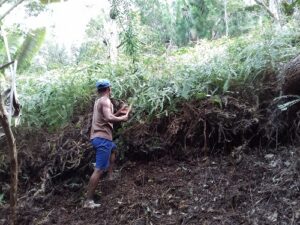Analalava Forest
Location
Madagascar - Mahavelona Commune in the central-eastern Atsinanana Region
Category
Site (part of the Madagascar Research and Conservation Program EcoHealth Hub)
Ecosystem
Low-elevation evergreen forest
Land Tenure
Protected Area with co-management by Missouri Botanical Garden and the local community
Contacts
Anselme Tilahimena, Missouri Botanical Garden-Madagascar Research & Conservation Program
Website
Area of the site: 209 hectares
Date of initiation: 2006
Institutional collaborators: Malagasy Government; Missouri Botanical Garden; Madagascar Fauna and Flora Group; TSINJOALA (local NGO)
Ecological importance of the site

• Rare fragment of low-elevation humid forest.
• The only natural vegetation remaining in Mahavelona Commune.
• High botanical diversity (430 species of higher plants inventoried to date).
• Several threatened and locally endemic plants (8 species now known only from this site).
• 26 species of palms.
• Five species of lemur.
Socio-economic importance
• Formerly heavily used as source of timber and firewood.
• Currently used by local schools for environmental education.
• High potential for tourism.
• Source of several streams that irrigate adjacent rice fields.
Restoration efforts underway

When the conservation program began in 2006, the forest was badly degraded due to exploitation of trees for timber and charcoal, conversion of the forest to agricultural land, and wildfires. These pressures have since been brought under control. Active restoration measures taken at the site include:
• Installation and annual maintenance of a 12 km long firebreak around the entire forest (to enable natural regeneration).
• Daily patrols to spot wildfires and prevent non-sustainable exploitation of wood from native trees.
• Propagation of native tree seedlings in village nurseries to enable restoration of highly degraded forest where natural regeneration is likely to be slow.
• Research to define best practices for restoration and develop restoration protocols.

In parts of the forest with a history of cultivation and repeated burning (approx. 30 ha), the land remains covered with a thick layer of the native colonizing fern Dicranopteris linearis, which seems to be an unsurmountable obstacle to natural regeneration of the forest. In these zones, restoration activities are focused on controlling the fern and planting a variety of locally grown native trees (including amongst many other species: Macaranga obovata and Canarium lamianum). However, the fern is resilient, and experiments are underway to identify the best approaches to restore native forest in these areas despite its presence.
Some parts of the forest also contain the alien invasive pyrophytes: Litsea glutinosa, Grevillea banskii and Melaleuca quinquinervia. In the future, these plants, which increase the site’s vulnerability to wildfires and will need to be controlled.
Key accomplishments to date
• No wildfires have entered the protected area since 2014, when 5 ha of degraded forest burned.
• There has been no exploitation of wood from the forest since 2006.
• Restoration of native forest has been initiated over 10 ha of grass- and fern-covered shrubland within the protected area, with a seedling survival rate above 80%. Growth is slow, however.
• Monitoring has shown robust regeneration of moderately degraded forest, with an increase in mean woody biomass (stems >10cm) from 14.9 m²/ha in 2006 to 23.58 m²/ha in 2019.

